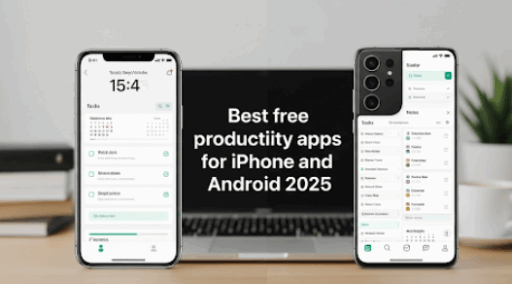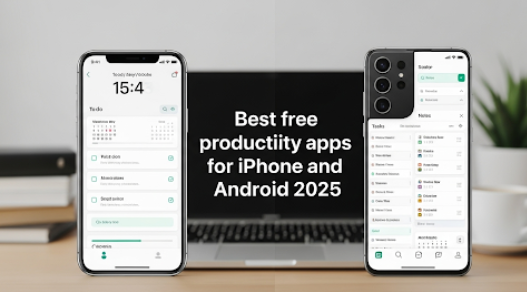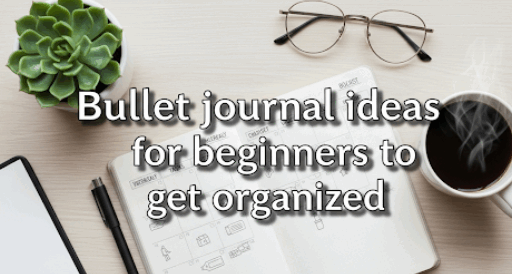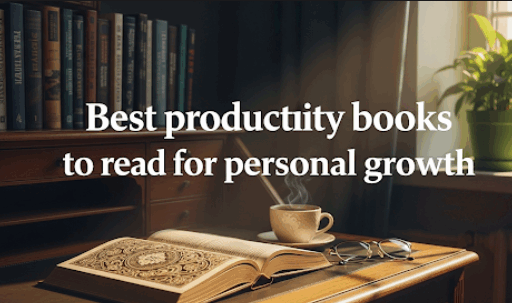Top 5 Free Productivity Apps for iPhone & Android in 2025
You don’t have to spend a fortune to get things done in 2025. No matter if you are a student, an employee with great responsibility load, or just yourself trying to manage what is on your plate. The best part? Many of these powerful instruments are 100% free.
Developers have created powerful apps that compete with expensive desktop software. Using your smartphone which acts as a productivity guru without even paying a dime, from task management to note-taking, the extensive world of time tracking to team collaboration is just there in front of you.
This article is a detailed guide with the top productivity apps for free on iPhone and Android in 2025. These are not only simple apps; they are the full package that can increase your productivity and keep you in order.
Task Management Apps that Work!
Todoist: The Smart Task Organizer
Out of all the task management apps, Todoist always comes on top. It is suitable for students and all individuals who just want to organize their lives—they can utilize the tons of features that its free plan offers.
Key Features:
- Fast task entry using natural language processing
- Project organization with color coding
- Basic labels and filters
- Cross-platform synchronization
- Up to 5 people per project collaborate easily
Why It’s Awesome: You can just type “Meeting with Sarah tomorrow at 3pm,” and Todoist will convert that into a date and time. Its clean interface allows the user to see what needs to be done at a glance, and lets you track what has been done, keeping you motivated.
Ideal For: Students, freelancers, or anyone needing simplicity in a project management solution
Microsoft To Do: Integration Champion
Microsoft To Do is well adapted for the Microsoft ecosystem, so if you are already using Outlook or Word, then Microsoft To Do makes it the right option. Built on the foundation of beloved Wunderlist, this app retains its easy approach.
Key Features:
- Seamless integration with Outlook tasks
- Family and team collaboration across shared lists
- File attachments up to 25MB
- Suggestions based on patterns you have established
- Daily Focus-created “My Day” feature
Best For: Office workers, students that use Microsoft 365, and family members who need to share grocery lists or chores.
Any.do: The Visual Task Manager
Any.do is styled as a visual task manager. The calendar integration and the moment feature help you manage your day better than tedious to-do lists.
Standout Features:
- Calendar view for improved time visualization
- Hands-free task creation by voice entry
- Location-based reminders
- Grocery list templates
- Daily planner with time blocking
Note-Taking Apps for Every Style
Notion: The All-in-One Workspace
Notion re-imagined note taking by marrying databases, wikis, and documents into one flexible platform. Although it can be a little daunting at first glance, the free version provides an amazing amount of value.
What Makes It Special:
- Block-based editing system
- Database functionality for organizing information
- Templates for common use cases
- Basic team collaboration features
- Web clipper allows you to save online content
Time Investment: Moderate to high, but good for power users.
Obsidian: The Knowledge Network
Unlike traditional note-taking, Obsidian makes links between your notes visually. This has made it great for research, learning, and knowledge tracking.
Key Advantages:
- Graph view showing note relationships
- Powerful linking system
- Plugin ecosystem for customization
- Local file storage for privacy
- Markdown-based formatting
Ideal Usage: For students, researchers, writers, or anyone looking to create a universal and connected body of knowledge.
Google Keep: Simple and Effective
Sometimes simple is the best. Google Keep is great for quick notes, to-dos, shopping lists, etc.
Why People Love It:
- Synchronization across all Google services in real time
- Voice notes with automatic transcription
- Image text extraction using OCR
- Color coding and label organization
- Location and time-based reminders
Time Management and Focus Apps
Forest: Gamified Focus Sessions
Forest takes an innovative approach to maintaining productivity through gamification. You plant a tree that grows as you work and disappears if you use your phone. Go out of the app and your tree will die.
Unique Features:
- Pomodoro timer with visual feedback
- A virtual forest that grows while you are productive
- Real tree planting partnerships
- Focus statistics and trends
- Study room features for group sessions
Great For: Students, anyone working from home, and those distracted by their phones.
Toggl Track: Professional Time Tracking
Professional level time tracking is included in the free tier, making this a worthwhile tool for individuals working from home.
Professional Features:
- One-click time tracking
- Project and client organization
- Detailed reporting and analytics
- Time tracking for up to 5 users
- Integration with popular productivity tools
RescueTime: Automatic Activity Monitoring
RescueTime runs in your background without taking time to automatically monitor how you spend time on your devices. Provides unique insights without human intervention.
Automatic Insights:
- Detailed activity categorization
- Productivity scoring
- Weekly email reports
- Goal setting and alerts
- Website and app blocking (premium only)
Communication and Collaboration Tools
Slack: Team Communication Hub
Like other popular workplace communication tools, Slack completely changed the way we communicate in our workspace, and for small teams or personal usage, it offers a lot of generous free features.
Communication Features:
- Unlimited messaging with 90-day history
- File sharing and screen sharing
- Voice and video calls
- App integrations
- Custom channels for organization
Discord: Beyond Gaming Communication
True, Discord was built for gamers from the start, but it has grown into a powerful communication tool for everything from study groups to project groups to art communities.
Why It’s Versatile:
- Voice channels for ongoing collaboration
- Screen sharing and streaming
- Robust moderation tools
- Bot ecosystem for automation
- Cross-platform availability
Document Creation and Editing
Google Workspace: Cloud-Based Productivity
Professional-level document creation and collaboration tools are included absolutely free with Google’s suite of productivity apps.
Included Apps:
- Google Docs for word processing
- Google Sheets for spreadsheets
- Google Slides for presentations
- Google Drive file storage (15GB free)
- Real-time collaboration features
Microsoft Office Mobile: Full Power in an App
Microsoft has full-featured mobile apps of its Office application suite available for phone and tablet users.
Mobile Advantages:
- Full editing capabilities
- Cloud synchronization
- Familiar interface for Office users
- PDF creation and editing
- Integration with OneDrive
Specialized Productivity Apps
Pocket: Read Later Solution
Pocket is an app that allows you to save awesome articles for later so you finally have time to check them out. Keep your reading list from any of the websites or apps you use.
Reading Features:
- Offline reading capability
- Clean, distraction-free reader
- Article recommendations
- Highlighting and tagging
- Audio playback for hands-free consumption
IFTTT: Automation Made Simple
If This Then That (IFTTT) gives you the ability to create automation-rich experiences between various apps and services without any need for programming skills.
Automation Examples:
- Back up your Instagram photos to Google Drive
- Get weather text notifications
- Auto-fill work hours in spreadsheet
- Create calendar events from emails
- Update social media across platforms
CamScanner: Mobile Document Scanner
CamScanner is an app that turns your phone into a powerful document scanner, negating the need for physical scanners and copiers.
Scanning Capabilities:
- High-quality document scanning
- Automatic edge detection and enhancement
- OCR text recognition
- PDF and image output formats
- Cloud storage integration
Top Free Productivity Apps Comparison
| Category | Winner | Runner-Up | Honorable Mention |
|---|---|---|---|
| Task Management | Todoist | Microsoft To Do | Any.do |
| Note Taking | Google Keep | Notion | Obsidian |
| Time Tracking | Toggl Track | Forest | RescueTime |
| Communication | Slack | Discord | Google Meet |
| Documents | Google Docs | Microsoft Word Mobile | Notion |
Platform-Specific Recommendations
iPhone Users: iOS Integration Champions
iPhone users benefit from apps that integrate deeply with iOS features.
Top iOS Picks:
- Apple Notes – Deep iOS integration, Siri, Shortcuts, iCloud
- Apple Reminders – Location-based reminders and Siri voice control
- Shortcuts – Deep automation capabilities on iOS
- Files – Central file management combined with cloud services
Android Users: Customization and Flexibility
Android’s openness makes it significantly more flexible and capable of powerful automation:
Android Advantages:
- Google Assistant – Voice productivity commands
- Tasker – Automation beyond IFTTT
- Widget support – Home screen widgets for easy access
- Default app changes – Setting default apps to your productivity favorites
Setting Up Your Productivity System
Week 1: Foundation Building
- Pick a task management app and transfer all of your to-dos
- Set up your note-taking system, either Google Keep or Notion
- Install a time tracking app
Week 2: Communication and Collaboration
- If you work with others, set up team communication tools
- Set up file sharing and collaborative documents
- Test automation tools for repetitive tasks
Week 3: Optimization and Integration
- Connect apps in seamless workflows where possible
- Set up smart notifications and reminders
- Customize settings specifically for you
Week 4: Review and Refine
- Assess your usage patterns and productivity gains
- Remove apps that aren’t adding value
- Optimize settings and workflows
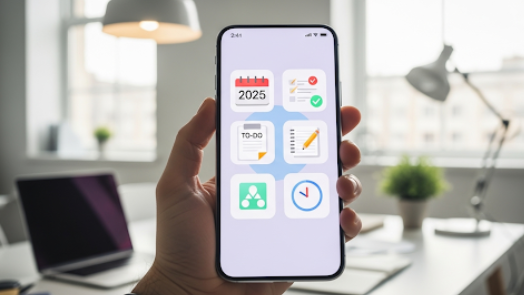
Common Mistakes to Avoid
App Overload Syndrome
The problem with installing too many productivity apps is that it can make you even less productive. Find 3-5 core apps that have strong synergy rather than trying every new thing promising to change your life.
Ignoring Integration Opportunities
Powerful integrations with other apps become unavailable to many users. Connect your productivity tools, and invest the time to create workflows that save you minutes, which can accumulate over time.
Neglecting Mobile Optimization
Others just try to transform their desktop workflow onto a mobile device. Use mobile features (voice input, location awareness, touch gestures) instead.
The Future of Mobile Productivity
AI Integration
Productivity apps are increasingly powered by artificial intelligence. Features such as smart scheduling, automated categorization, and predictive text entry are no longer the exception but often mainstream.
Privacy-First Approaches
Users are careful about data privacy—hence, they prefer apps with local storage and transparent privacy policies.
Cross-Platform Consistency
The gold standard in modern productivity apps is a seamless experience that works the same on your phone, tablet, or computer, meaning you can start something on one device and continue it later when convenient elsewhere.
Getting the Most out of Free Apps
Understanding Limitations
Free versions of productivity apps often have storage limits, limited collaboration, or lack advanced features. Still, the limits typically do not affect casual or individual use.
Maximizing Value
- Use multiple apps within the same company (the more apps, the better they integrate)
- Get education discounts if you are a student
- Join beta programs to start utilizing new features early
- Follow app developers on social media for additional useful tips
Conclusion
The world of free productivity apps is powerful and smartphone-appropriate in 2025. Whether you’re organizing your personal life, managing work projects, or collaborating with teams, chances are there’s a free solution that will cover your use case.
Success isn’t necessarily in finding the perfect app but rather in finding the right apps that work well together and with your workflow. Start with the fundamentals: task, note, and time management. Unless you need more than the most basic tools, learn what you need and add specialized tools bit by bit.
Keep in mind that the best productivity system is actually the one you use on a regular basis. Don’t get caught in endless optimization cycles, and avoid jumping between apps consistently. Select tools that are comfortable, relevant to your life, and actually help you achieve what you want.
This free mobile productivity guide shows you amazing apps that will help you stay organized and productive on the go in 2025 for FREE. All of them provide real value, suitable for everyone regardless of budget. Your smartphone already has the power to transform your entire life—now you have a way to put that power to effective use.
Take the first step today: download a task management app and a note-taking app. Start them with simple entries, and you should be on track to having an organized mobile experience that is more efficient and productive. The future of productivity is in your pocket—and it’s completely free.
